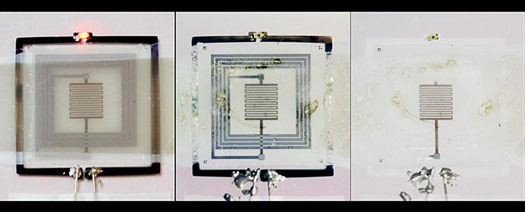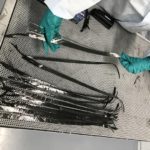Where do electronics go when they die? Most devices are laid to eternal rest in landfills. But what if they just dissolved away, or broke down to their molecular components so that the material could be recycled?
University of Illinois researchers have developed heat-triggered self-destructing electronic devices, a step toward greatly reducing electronic waste and boosting sustainability in device manufacturing. They also developed a radio-controlled trigger that could remotely activate self-destruction on demand.
The researchers, led by aerospace engineering professor Scott R. White, published their work in the journal Advanced Materials (“Thermally Triggered Degradation of Transient Electronic Devices”).
“We have demonstrated electronics that are there when you need them and gone when you don’t need them anymore,” White said. “This is a way of creating sustainability in the materials that are used in modern-day electronics. This was our first attempt to use an environmental stimulus to trigger destruction.”
White’s group teamed up with John A. Rogers, a Swanlund chair in materials science and engineering and director of the Frederick Seitz Materials Laboratory at Illinois. Rogers’ group pioneered transient devices that dissolve in water, with applications for biomedical implants. Together, the two multi-disciplinary research groups have tackled the problem of using other triggers to break down devices, including ultraviolet light, heat and mechanical stress. The goal is to find ways to disintegrate the devices so that manufacturers can recycle costly materials from used or obsolete devices or so that the devices could break down in a landfill.
The heat-triggered devices use magnesium circuits printed on very thin, flexible materials. The researchers trap microscopic droplets of a weak acid in wax, and coat the devices with the wax. When the devices are heated, the wax melts, releasing the acid. The acid dissolves the device quickly and completely.
To remotely trigger the reaction, researchers embedded a radio-frequency receiver and an inductive heating coil in the device. The user can send a signal to cause the coil to heat up, which melts the wax and dissolves the device.
Watch a video of the researchers demonstrating and explaining the devices:
“This work demonstrates the extent to which clever chemistries can qualitatively expand the breadth of mechanisms in transience, and therefore the range of potential applications,” Rogers said.
The researchers can control how fast the device degrades by tuning the thickness of the wax, the concentration of the acid, and the temperature. They can design a device to self-destruct within 20 seconds to a couple of minutes after heat is applied.
The devices also can degrade in steps by encasing different parts in waxes with different melting temperatures. This gives more precise control over which parts of a device are operative, creating possibilities for sophisticated devices that can sense something in the environment and respond to it.
White’s group has long been concerned with device sustainability and has pioneered methods of self-healing to extend the life of materials.
“We took our ideas in terms of materials regeneration and flipped it 180 degrees,” White said. “If you can’t keep using something, whether it’s obsolete or just doesn’t work anymore, we’d like to be able to bring it back to the building blocks of the material so you can recycle them when you’re done, or if you can’t recycle it, have it dissolve away and not sit around in landfills.”
Photo 1’s caption: A device is remotely triggered to self-destruct. A radio-frequency signal turns on a heating element at the center of the device. The circuits dissolve completely. (Image: Scott White, University of Illinois)
Photo 2’s caption: Scott White














